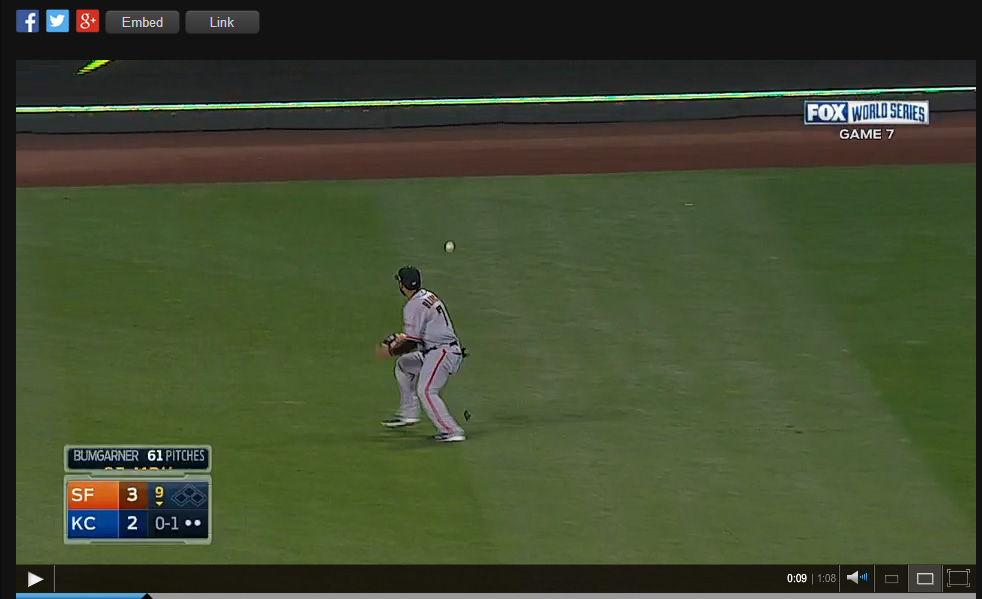A good World Series always provides a “what were you thinking?” moment to keep us distracted through the winter.
As a fan of the Cleveland franchise — a team that hasn’t won a World Series since six years before my father forgot to go to the pharmacy — we know what it’s like, Royals fans.
It was game seven in 2007, Kenny Lofton racing around third on a hit by Franklin Gutierrez in the 7th inning, the Cleveland trailing by a run. Lofton, who still had a little speed in his advanced age, was on second. Players on second score on singles; that’s just the way it works. So Joel Skinner, the third base coach, held Lofton at third. That’s just the way it works in Cleveland.
The next batter hit into a double play and the dastardly Red Sox — who can only win when they cheat, it must be pointed out — went on to win a World Series.
Last night’s situation was even more dire for the Royals. Bottom of the 9th, down a run against a great pitcher and Alex Gordon rounding third when the “stop” sign came out.
“When it got by him, I had a smile on my face. I thought maybe I could score, but he got to it quickly enough,” Gordon told Fox Sports. “I just put my head down and ran, almost fell around second base, was just waiting for Jirsch (third base coach Mike Jirschele) to give me the signal. It was a good hold. He had the ball in plenty of time.”
The next batter popped out to end the game and Series, and start our winter of discontent.
Statsman Nate Silver went to the calculator and determined that Gordon should have tried to score; even if the odds are he would’ve been out, they were still better than the odds of the next batter succeeding.
Between 1969 and 1992 — I’m using this period because it better approximates baseball’s current run-scoring environment than the offensive bubble of the 1990s and aughts — a runner scored from third base with two outs about 27 percent of the time, according to the tables at Tangotiger.com. We should probably round that down a bit in this example. The Royals had Santiago Perez at the plate — a league-average hitter — and the light-hitting Mike Moustakas due up after that.
More importantly, they were facing Madison Bumgarner. That Bumgarner had been so dominant in the World Series is not as relevant as you might think. There’s extremely little evidence for a “hot hand” in pitching: In-game performance tells you next to nothing about how the pitcher will fare in future at-bats. Instead, you should look toward longer-term averages. Still, I feel comfortable asserting that Bumgarner was an above-average pitcher at that moment: Certainly not the first guy you’d want to have on the mound if you were the opponent. So let’s round that 27 percent down to 25 percent.
So, Gordon should have tried to score if he had even a 25 percent chance of being safe?
It’s just a touch more complicated than that. With the Royals down 3-2, Gordon represented the tying run rather than the winning run. If he’s thrown out at home, the game’s over; it forecloses on the possibility of Perez scoring as the winning run, like with a walk-off homer. What was the probability of that? Perez homered in about 3 percent of his plate appearances this season, but he could also have scored in other ways — by doubling, for example, and then scoring on a base hit by Moustakas. We can turn to Tangotiger’s tables again, which suggest that a league-average batter has about a 6 percent chance (I’m rounding down slightly) of eventually scoring from home with two outs.
So, after Gordon holds at third, he has a 25 percent chance of scoring. Six percent of the time, Perez (or pinch-runner Jarrod Dyson?) also scores, and the Royals win outright. The other 19 percent of the time, Gordon is the only Royal to score in the ninth and the game goes to extra innings. If we assume the Royals are even money to prevail in an extra-inning game, their chances of winning at that point are:
6% + (19% * 50%)
That works out to 15.5 percent. Not coincidentally, this matches FanGraphs’ in-game win probability for the Royals (after Gordon held at third) almost exactly.
What if Gordon rounds third and tries to score? If he’s successful even 30 percent of the time, the Royals’ win probability is at least 15 percent — a 30 percent chance of Gordon scoring, multiplied by a 50 percent chance of the Royals winning in extra innings. But it’s slightly higher than that. The 30 percent of the time that Gordon scores, Perez still has his 6 percent chance of scoring the winning run in the ninth. That brings the Royals’ overall win probability up to about 16 percent.
Nonsense, suggests Timothy Burke at Deadspin. Baseball is a game of numbers and the numbers don’t lie. He calculated that it takes 15 seconds for Gordon to run the bases and the Giants fielders were ready to throw him out 12 seconds into the play, and it doesn’t take 3 seconds for the ball to reach home.
“Our numbers are based on the best possible performance for Gordon and the worst possible performance for the fielders,” he writes. “Suggesting that ‘they might have bobbled it again!’ but not that ‘Gordon might miss a stride!’ is a bit disingenuous.”
It was another metaphorical moment for the greatest game ever invented. There is is risk in reward and, sometime, failure in playing it safe.
Hurry back, baseball.


